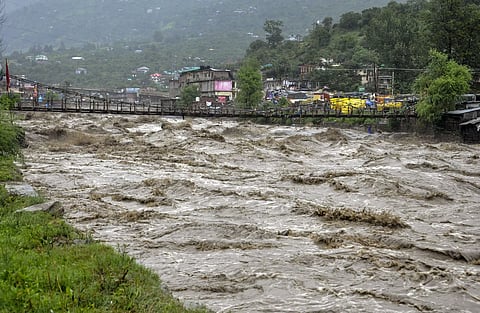

NEW DELHI: Several regions of north India have been beset by extreme weather events over the past few weeks. Fatalities were reported in the rain-hit states of Himachal Pradesh, Uttarakhand, Punjab, Haryana and Uttar Pradesh, which has taken the overall death toll from this monsoon’s rain, flash floods and landslides to 150 in these states. Things looked grim in New Delhi as well. The torrential Yamuna river swelled to a staggering 208.66 metres, breaching its all time record high of 207.49 m which was recorded 45 years ago. Nearby streets and public and private infrastructure were inundated, which caused immense hardships to people living in close proximity to the river. CM Arvind Kejriwal appealed to those living in low lying areas to immediately evacuate their homes.
The episodes serve as reminders of how cities in India are rendered vulnerable due to the impact of climate-change induced extreme weather. For instance, in less than one month since the onset of monsoon (from June 24 to July 10), the state of Himachal Pradesh alone has experienced over 41 incidents of landslips, coupled with 29 flash floods and one cloudburst. At least 80 people have died in the aftermath of such events. Questions are now being raised as to how much of this destruction in the Himalayan region can be attributed to human activity? And can these episodes be grouped under man-made disasters?
Environment-focussed NGOs believe that the flash floods were triggered by excess rains, but were also made stronger by the dumping of debris and muck alongside riverbanks and streams. The factors responsible include change in land use, deforestation-led erosion, construction-induced destabilisation of slopes. A major cause of concern is the construction along river beds in flood plain regions, which blocks the river path. Excavation of the region, chopping off trees, digging slopes to build highways, roads, buildings, dams and other infrastructural projects also have led to flash floods.
The constant development cycles have significantly contributed to phenomena such as landslides, land subsidence, as well as removal of vegetation and erosion of soil. In the case of New Delhi, administrators had argued that the city’s drainage system was not designed to handle such an unprecedented downpour. The PWD remarked that the capital’s drainage network can carry a maximum of 50 mm of rainfall in a period of 24 hours and that it is in urgent need of reconstruction.
But then, New Delhi, like many other Indian cities, has been witnessing instances of heavy rain increasingly over the last decade. In 2021 itself, the city had seven episodes of heavy rains that had precipitated flooding on par with what we are seeing right now.
Per a Drainage Master Plan prepared by IIT-Delhi, mismanagement of the drainage network was the numero uno cause for dysfunction during adverse weather. Issues highlighted by the plan include: rampant encroachment of stormwater drains; dumping of sewage, garbage, road dust, construction debris into drains. Public utilities such as flyovers and metro-rail pillars encroaching upon drainage space is also a problem. Poor design, alignment and construction of drains have also hampered their functioning severely.
Experts suggest the need to rejuvenate water bodies as well as encourage rainwater harvesting in parks and open spaces, which will help act as absorbent sponges and reduce flooding. Even our city Chennai has lessons to learn from the lashing visited upon New Delhi — As you make your bed, so you must lie in it.